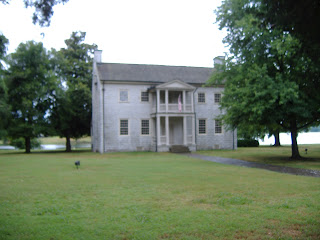Driving from the flatlands of our Iowa Prairie to the mountains in North Carolina is an ever-changing scene in the spring! The view through the windshield of the motor home included: smooth fields planted with corn & soybeans, wildflowers blooming in the ditches and medians, road construction signs, flowers blooming in yards and gardens and the mountains covered with trees wearing leaves in many shades of green and accented with the white blossoms of shrubs and fruit trees. Fresh is the keyword!!
At exit 148 on Interstate 40 a sign for Hiddenite Center Museum caught our attention. Driving on a two-lane blacktop with no shoulders we passed many small factories and small towns each with a Dollar General Store. Azaleas, iris and even roses were blooming in the neat yards. Still following the arrows past small farms to a small town, Hiddenite, nestled in the foothills of the Brushy Mountains.
Hiddenite Center Museum

A large three-story turn-of-the-century Victorian House with a continuous porch all around and 3 tall brick chimneys on the roof and a sign in front showing our destination. We were a little early for its 10:00 opening time so enjoyed our coffee sitting on a bench on the porch in the quiet neighborhood. The fragrance of boxwood plus the ivy covering the white fence and ground beneath were definite clues we were in the south! A gazebo and an old-fashioned covered well with winch and pail sit on the side lawn.

Our tour guide explained that the house was owned by James Lucas, known as "Diamond Jim" Lucas. Two stories were built around 1900 in the Victorian style. Mr. Lucas purchased the house to use as a second home. He lived up North, but came to the Hiddenite area to hunt. The house had its own electrical power generation plant, water system, bell system to summon the servants, and a fire extinguisher system. The first floor is restored to capture the era when he occupied the residence.

A Victorian Chocolate Set
A Victorian Tea Party--note how the dolls have "mature" faces!!!
About 1915 the man who owned the Pilot Freight Carrier Company, Ruel Yount Sharpe, cut the house in half horizontally and lifted the second story up to become the third story. A second story was built between the two original floors! It was a bed and breakfast after the style of an English Country Inn for many years. After the Inn closed his wife, Mrs. Eileen L. Sharpe, started a gallery for artists.
Today the second floor gallery of the Masion features changing exhibits of art and history. On the third floor is a doll collection dating from the 1800's, on loan from Mrs. Sharpe. There are approximately 550 dolls.
Included in the Mansion is a local gem and mineral collection. The Emerald Hollow Mine has 63 different types of naturally occurring gems and minerals. It is the only place on earth where the very rare gemstone "Hiddenite" can be found. What is Hiddenite? It was first discovered in 1879 by Mr. W.E. Hidden in the mine in this area. It is an emerald green spodumene mineral named after him. They are also called lithia emeralds. Several large specimens are in various gem collections all over the United States. The mine is still open to the public for prospecting.
Fort Defiance

Another out-of-the-way interesting history lesson can be found near the town of Lenoir. This five acre plot with a huge chestnut tree and cypress tree dating from the civil war, a 200 year old boxwood garden and a family cemetery is what is left of 2,000 acres William Lenoir purchased in the mountains near the site of Ft. Defiance.

William Lenoir, a Major General in the North Carolina militia gained fame through his written account of the Battle of Kings Mountain in 1780. It was a pivotal victory for the American colonies during the Revolutionary War.
He began building his home on the North Carolina frontier in 1788 finishing it in 1792. He found the location while he was surveying the area, calling it the "sweetest spot on the earth." Members of the Lenoir family have continuously lived in the home until 1961. There are 300 pieces of original furnishings and artifacts. A separate outside entrance to his office allowed him to work out of his home. A taste of life on the frontier after the Revolutionary War.
Some miles on the Blue Ridge Parkway and back to the Interstate through West Virginia, Ohio, Indiana, Illinois and to the Prairie!













